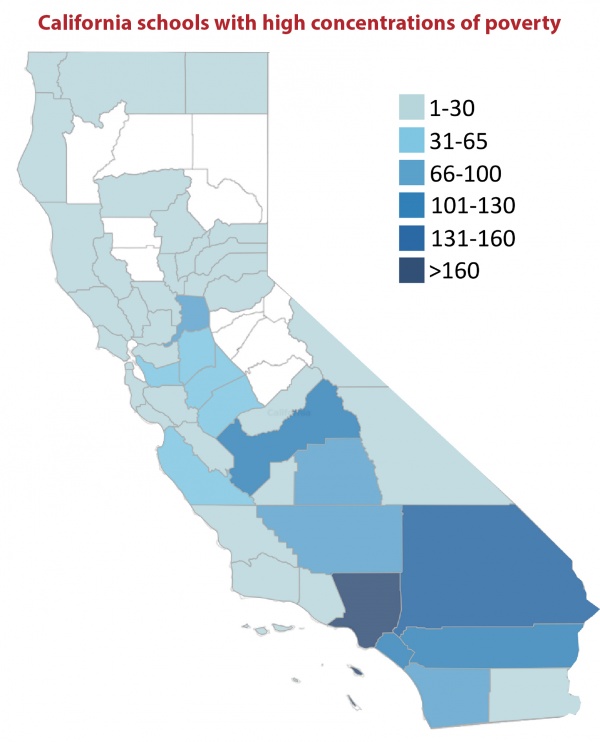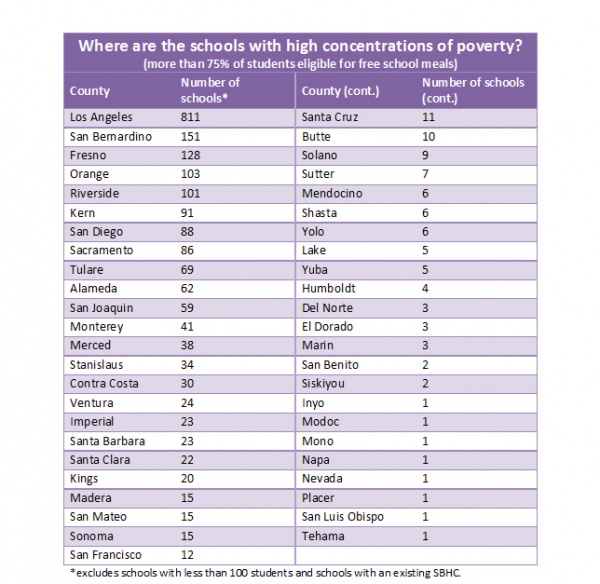There are more than 10,000 schools in California – and only 2% of the schools have an SBHC.(1) There are a variety of ways to think about the need for a school-based health center (SBHC). SBHCs provide benefits to children, families, and communities at all socioeconomic levels.
However, we know that there is a particular need in low-income areas. An abundance of research connects poverty to poor educational and health outcomes, high rates of teen pregnancy, and greater risk of dropping out of school. (2,3,4)
SBHCs can significantly impact the needs of children living in the state’s most distressed neighborhoods where children and families are uninsured, experience barriers to accessing preventive health care, have high rates of emergency room visits, obesity, asthma, and exposure to violence and trauma.
2,151 Schools Have High Concentrations of Very Poor Students
 As a first step, we determined how many schools in California have very high concentrations of poverty. We defined this as schools where over 75% of students qualify for free school meals. Children are eligible for free meals when their family income is at or below 130% of the federal poverty level. As an example, 130% FPL in 2014 equals an annual income of $31,005 for a family of four.
As a first step, we determined how many schools in California have very high concentrations of poverty. We defined this as schools where over 75% of students qualify for free school meals. Children are eligible for free meals when their family income is at or below 130% of the federal poverty level. As an example, 130% FPL in 2014 equals an annual income of $31,005 for a family of four.
We eliminated very small schools with less than 100 students where an SBHC may not be sustainable. From this pool of high need schools, 93 schools currently have an SBHC.
From these calculations, we found that there are 2,151 schools in California with high concentrations of poverty, where an SBHC could make a significant difference in the lives of students.
A Few Counties Have a Lot of Very Poor Schools
Five counties (Los Angeles, San Bernardino, Fresno, Orange, and Riverside) have 60% of the schools with high concentrations of poverty. See the included table and map for an overview of the number of schools with high concentrations of poverty by county.
Citations
1 Children Now, California Children’s Report Card – How kids are doing in our state and what needs to be done about it, (2014).
2 Susan E. Mayer, “Trends in the Economic Well-Being and Life Chances of America’s Children,” in Consequences of Growing up Poor, ed. Greg J. Duncan and Jeanne Brooks-Gunn (New York: Russell Sage Foundation, 1997): 46-69.
3 Jeanne Brooks-Gunn, Greg J. Duncan, and Nancy Maritato, “Poor Families, Poor Outcomes: The Well-Being of Children and Youth,” in Consequences of Growing Up Poor, ed. Duncan, G.J., and Brooks-Gunn, J. (New York: Russell Sage Foundation, 1997): 1-17.
4 Eugene M. Lewit, Donna L. Terman, and Richard E. Behrman, “Children and Poverty: Analysis and Recommendations,” www.futureofchildren.org.




